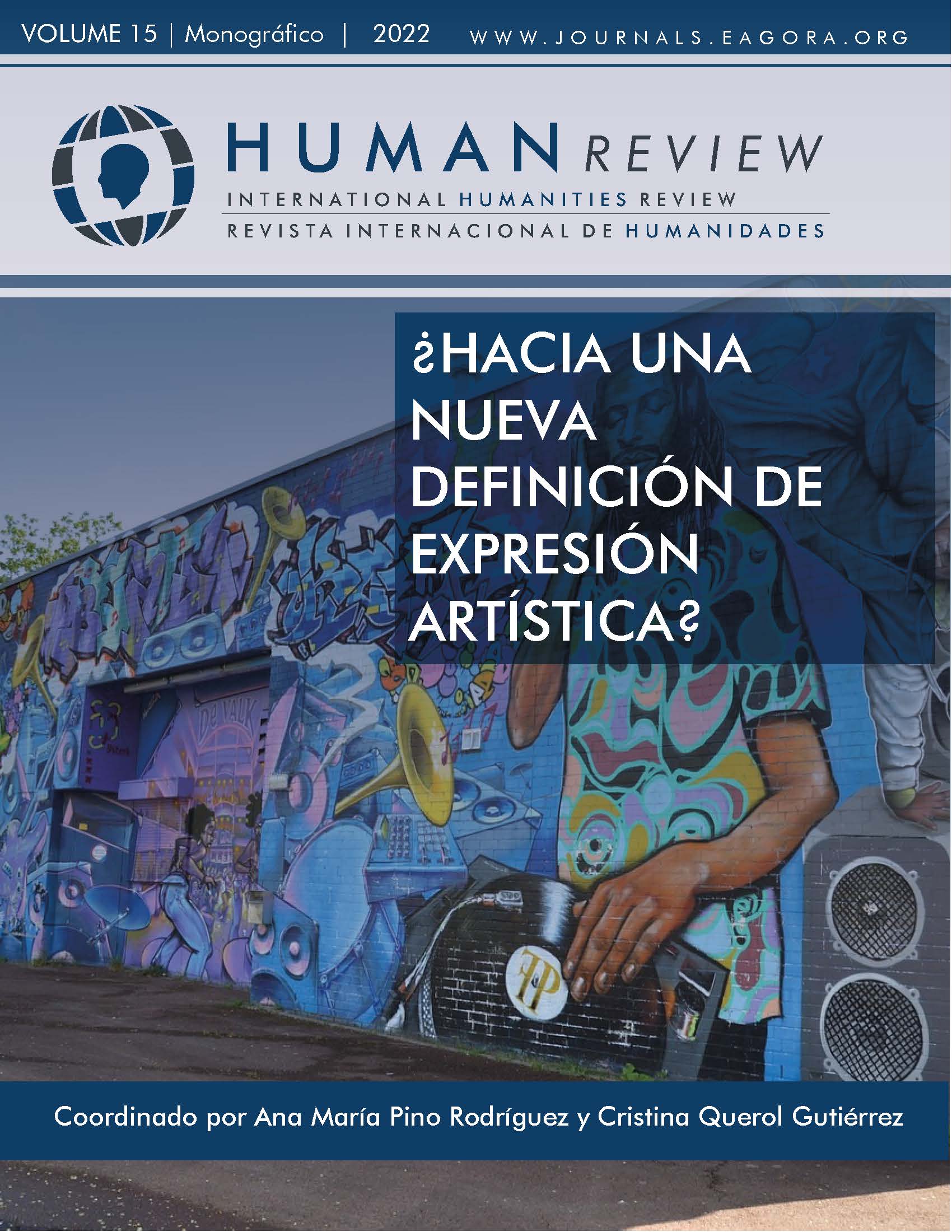The rise of urban locations in screendance
DOI:
https://doi.org/10.37467/revhuman.v11.4343Keywords:
Screendance, Cinedance, Filmic space, Locations, Audiovisual Language, DanceAbstract
This work arises as a result of a research whose objectives are to identify the types of scenic spaces, floors and locations used by screndances. For this purpose, we have analyzed 152 works chosen from the official selections of specific Spanish festivals, since their creation until 2018. For the analysis we have created an ad hoc model of nine variables and 44 categories. From the analysis we can conclude that screendance works preferentially uses framing centered on open and usually flat spaces, which are located in urban environments, generally indoors, with specific floors that bring meaning to the choreography or narrative of the videodance.
References
Alonso, R. (2010). Video danza: otro bastardo en la familia. En S. Szperling y S. Temperley (Eds.), Terpsícore en ceros y unos. Ensayos de videodanza (pp. 47-49). Guadalquivir, CCEBA y VideoDanzaBa.
Arnheim, R. (2019). Arte y percepción visual (3ª ed. 10ª reimpresión). Alianza Editorial.
Block, B. (2008). The visual story. Creating the visual structure of film, TV and digital media (2ª ed.). Focal press.
Brum, L. (2019). Reflexiones sobre historia, concepto y curaduría de la videodanza. En X. Monroy Rocha y P. Ruiz Carballido (Eds.), 04 Curaduría en Videodanza (pp. 24-75). Universidad de las Américas Puebla.
Burch, N. (2004). Praxis del cine (8ª ed.). Editorial Fundamentos.
Casetti, F. y Di Chio, F. (2017). Cómo analizar un film (11ª impresión). Espasa Libros, S. L. U.
Conrad, D. (2006). Getting of the stage [Conferencia]. Screendance: the State of the Arts Proceedings (pp. 102-104). American Dance Festival.
Del Portillo García, A. y Caballero Gálvez, A. (2014). Redefiniendo el videoarte: orígenes, límites y trayectorias de una hibridación en el panorama de la creación audiovisual española contemporánea. Icono 14, 12, 86-112.https://doi.org/10.7195/ri14.v12i2.707 DOI: https://doi.org/10.7195/ri14.v12i2.707
Dodds, S. (2004). Dance on screen. Genres and media from Hollywood to experimental art. Palgrave Macmillan. DOI: https://doi.org/10.1057/9780230509580
Eiroa, M. y Barranquero, A. (2017). Métodos de investigación en la comunicación y sus medios. Editorial Síntesis, S. A.
Fernández Consuegra, C. B., Llerena Fernández, A., Barbera Hernández, V. M. (2019). Composición, percepción visual y color para las artes escénicas (2ª ed.). Ommpress.
Gómez, C. y Urbizu, E. (2021). La caja de madera. Estudios sobre puesta en escena cinematográfica. ECAM y DAMA.
Hernández Sampieri, R., Fernández Collado, C. y Baptista Lucio, M. D. (2014). Metodología de la investigación (6ª ed.). McGraw – Hill
Igartua Perosanz, J. J. (2006). Métodos cuantitativos de investigación en comunicación. Editorial Bosch, S.A.
Kloetzel, M. (2016). Location, location, location: dance film and site-specific dance. En T. D. Arendell y R. Barnes (Eds.), Dance´s duet with the camera. Motion pictures (pp. 19-47). Palgrave Macmilan Publishers Lts. DOI: https://doi.org/10.1057/978-1-137-59610-9_2
Lachino, H. y Benhumea (Eds.), N. (2012). Videodanza. De la escena a la pantalla. Universidad Nacional Autónoma de México.
Llerena Fernández, A. (2021). Propuesta metodológica para el análisis de la videodanza a partir del lenguaje audiovisual. index.comunicación, 11(1), 165-185. https://doi.org/10.33732/ixc/11/01Propue DOI: https://doi.org/10.33732/ixc/11/01Propue
McPherson, K. (2019). Making video dance. A step-by-step guide to creating dance for the screen (2ª ed.). Routledge. Taylor and Francis Group. DOI: https://doi.org/10.4324/9781315452654
Monroy Rocha, X. y Ruiz Carballido (Eds.), P. (2015). 01 Memoria Histórica de la videodanza. Universidad de las Américas Puebla.
Payri, B. (2018). Life and death of screendance festivals: a panorama. En B. Payri y R. Arnal (Eds.), Videodance studies. Screendance festivals (pp. 3-66). Universitat Politècnica de València.
Payri, B. y Arnal Rodrigo, R. (2016). Análisis de los tipos de suelo en la danza audiovisual. En B. Payri y R. Arnal Rodrigo (Eds.), Proceedings of the international screendance meeting (pp. 49-62). Universitat Politècnica de València.
Rosenberg, D. (2019). Screendance: reiteraciones y sistemas generativos. En X. Monroy Rocha y P. Ruiz Carballido (Eds.), 04 Curaduría en videodanza (pp. 80-100). Universidad de las Américas Puebla.
Veras Costa, A. (2010). Kino-coreografías, entre el vídeo y la danza. En S. Szperling y S. Temperley (Eds.), Terpsícore en ceros y unos. Ensayos de videodanza (pp. 102-113). Guadalquivir, CCEBA y VideoDanzaBA.
Vitaglione, S. (2016). New materials: natural elements and the body in screendance. The international journal of screendance, 6, 94-111. DOI: https://doi.org/10.18061/ijsd.v6i0.4939
Downloads
Published
How to Cite
Issue
Section
License
Those authors who publish in this journal accept the following terms:
- Authors will keep the moral right of the work and they will transfer the commercial rights.
- After 1 year from publication, the work shall thereafter be open access online on our website, but will retain copyright.
- In the event that the authors wish to assign an Creative Commons (CC) license, they may request it by writing to publishing@eagora.org









